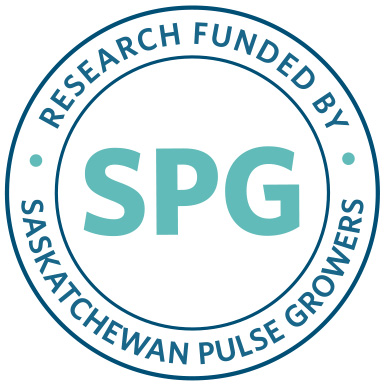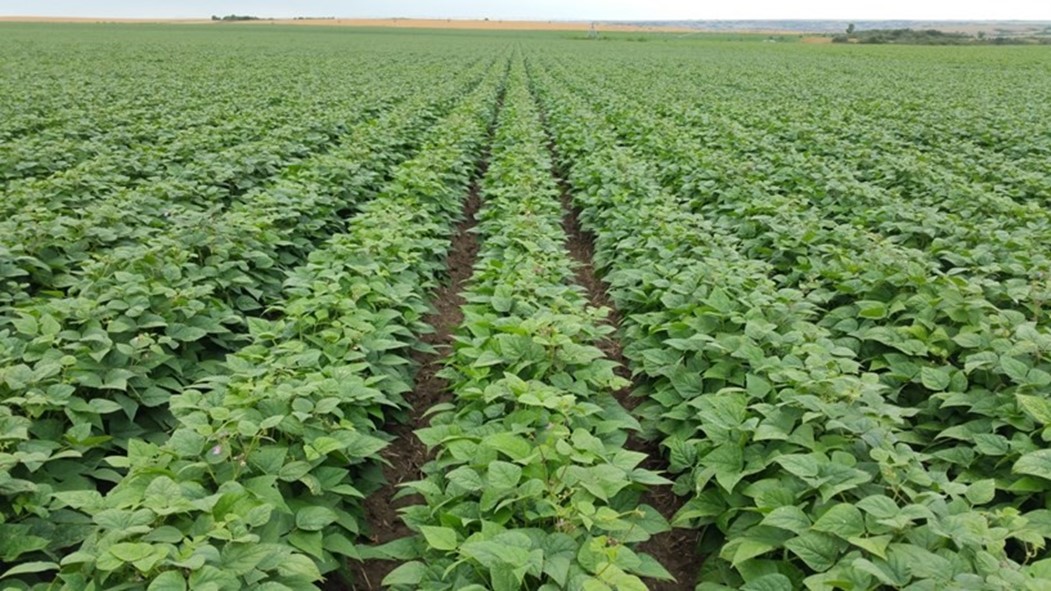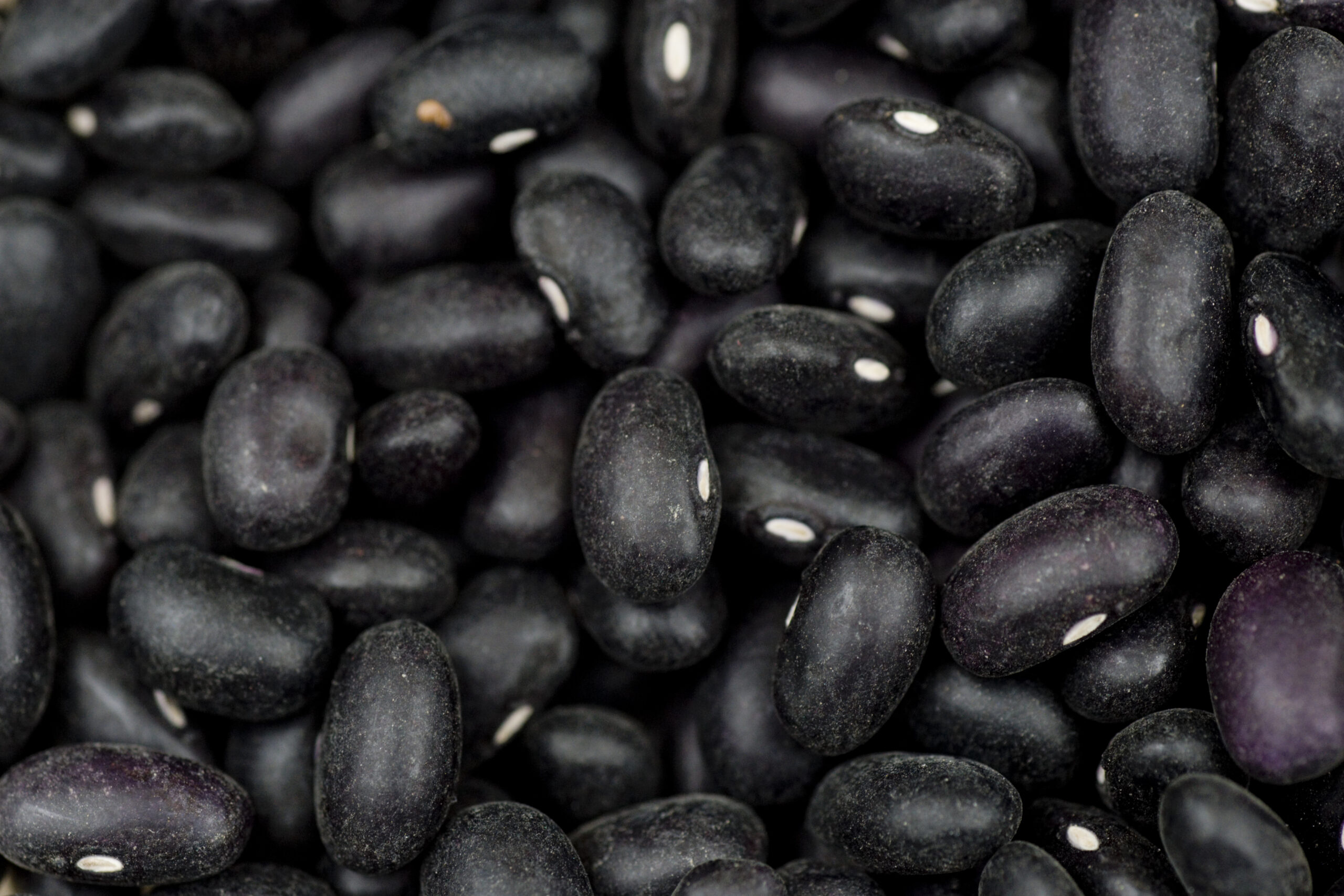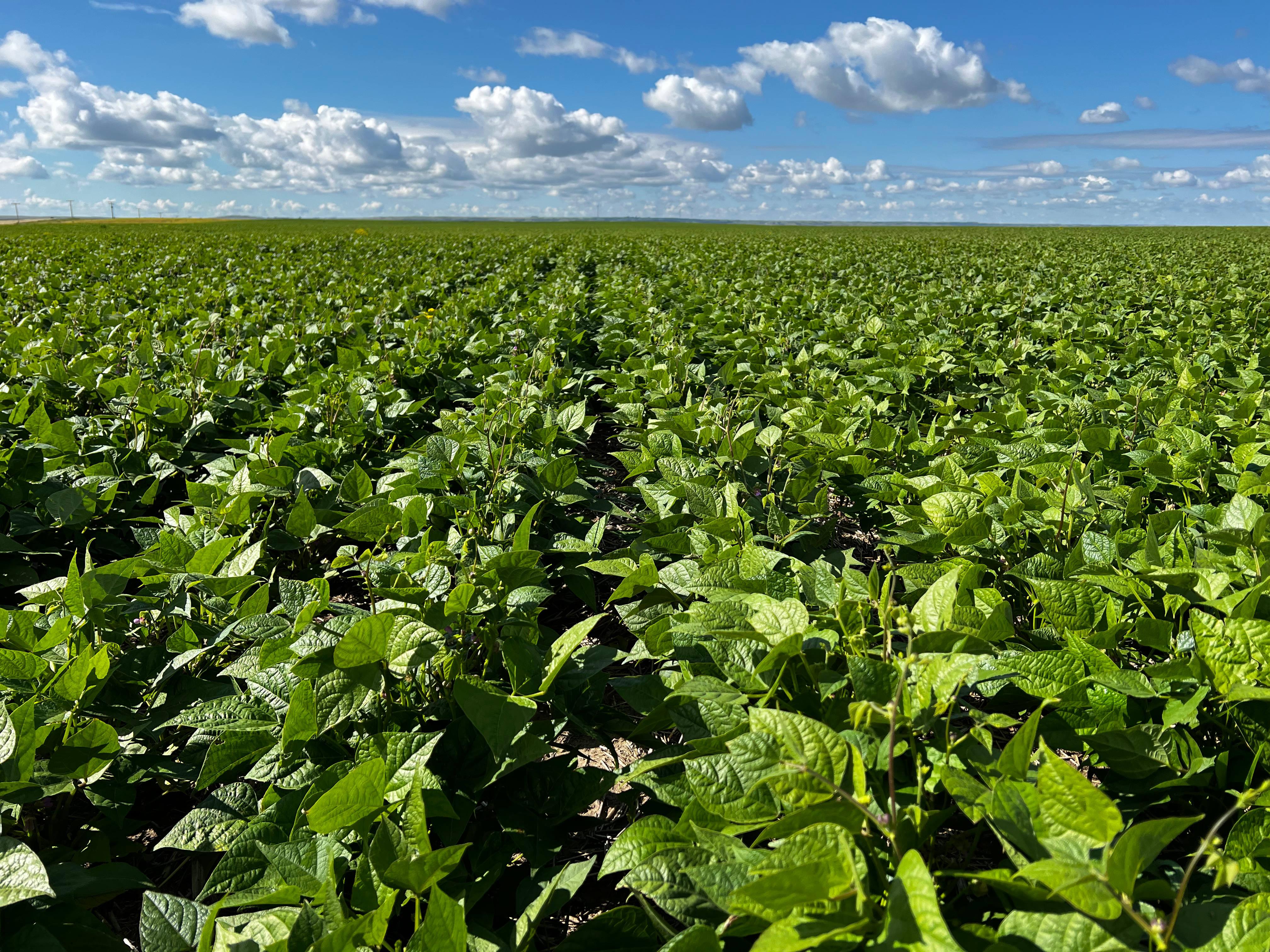Background
Dry bean production in Saskatchewan has remained consistent, around 10,000 acres, predominately under irrigation. Wide-row production of dry beans has created a barrier for most growers because of the need for specialized equipment. A narrow-row (solid- seeded) production system would allow for easier adoption of dry beans, as growers can use conventional farming equipment. Solid seeding may also allow for further expansion of dry beans onto dryland acres, with adequate rainfall, as another pulse crop option.
Purpose of the Project
To show that narrow-row dry bean production (solid seeding) is equal or superior to wide-row production (row cropping).
Design of Experiment
This project was carried out in 2017 by the Outlook Irrigation Crop Diversification Centre in the Riverhurst Irrigation District. An 80 acre centre pivot was split in half for a side-by-side comparison of a traditional wide-row production system on 22 inch rows, using a vacuum planter, compared to the solid seeded, narrow-row system, using an air seeder on 10 inch rows. CDC Blackstrap black beans were pre-treated with Apron Maxx® RT seed treatment, and had a germination of 98 per cent with seed moisture of 15 per cent.
Field operations are outlined in Table 1. Fertilizer targeted a 76-57- 20 blend of nutrients (nitrogen-phosphorus-potassium-sulfur) in pounds per acre (lb/ac), with wide rows prebanded, and narrow rows applied during the seeding operation. Nitrogen and potassium were placed through the mid-row banders, and phosphorus seed- placed.
Seeding occurred on May 29 with both systems. The wide-row system was seeded with a John Deere MaxEmerge™ vacuum planter, targeting 115,000 plants/ac or a 56 lb/ac seeding rate. The narrow-row seeding operation used a Bourgault 3320 Paralink™ hoe drill and Bourgault 6700™seed tank, with auger metering targeting 125,000 plants/ac or a 61.4 lb/ac seeding rate.
Seeding of the narrow rows took place at 3.8 miles per hour, at a seeding depth of one inch, into warm, moist soil. Air seeder fans were set to 5,500 revolutions per minute (rpm) on the mid-row banders, and 3,000 rpm on the seed row. Seed row fans were set high enough to avoid plugging, but as low as possible to reduce seed damage.
Table 1. Field Operations and Dates
| Wide-Row Side | Narrow-Row Side |
|---|---|
| Tandem disc — April 12 | – |
| Granular Edge™ and heavy harrow — April 13 | |
| Band fertilizer — April 20 | – |
| Cultivation — April 24 | – |
| Permit® — May 28 | |
| Seed — May 29 | Seed and fertilize — May 29 |
| – | Roll — immediately after seeding (May 29) |
| Viper® ADV and Basagran® herbicides — July 3 | |
| Inter-row cultivation —July 1 and 13 | – |
| Contegra® fungicide – July 20 | |
| Undercut— August 1 | Reglone® half — August 4 Swath half — August 5 |
| Combined — August 12 | |

Source: Irrigation Crop Diversification Centre
The dry beans were seeded on May 29, into warm, moist soil which resulted in quick emergence within seven days. Plant counts were taken on June 19, using a predetermined diametre hoop, with 10 counts per side.
Undercutting of the wide-row section was done at the buckskin stage, with a Pickett One Step. The narrow-row section was divided in half to compare swathing to straightcutting. At the buckskin stage Reglone® was applied to the half to be straightcut, while the other half was swathed. A Pickett Twin Master bean combine was used to harvest the wide rows and the swathed portion of the narrow rows. The remaining standing area of the narrow-row portion of the field was direct harvested with a Case IH 8230 rotary combine, using a MacDon FD75 FlexDraper® header.
Throughout the growing season beans were irrigated 11 separate times, for a total of 7.5 inches or 190.5 millimetres (mm) (Table 2). Irrigation application rates ranged from 0.5 inches (12.7 mm) to 0.75 inches (19.05 mm) per application.
A total of 3.78 inches (96.1 mm) of natural precipitation accumulated through the growing season. The vast majority of rainfall came in a single rain event in late May, and another single rain event in late August.

Source: Irrigation Crop Diversification Centre

Source: Irrigation Crop Diversification Centre
Results

Source: Irrigation Crop Diversification Centre
The wide-row area averaged 142,600 plants/ac or 20 per cent higher than the target. The planter seeding rate was set based on manufacturer manual settings, which resulted in a higher seeding rate than expected.
The narrow-row area averaged 98,000 plants/ac or 22 per cent lower than targeted. It is believed that more seed damage occurred through the air seeder than was observed at the time of seeding.
Permit® pre-plant, Viper® ADV, and Basagran® provided exceptional weed control in this demonstration. Climatic conditions in 2017 also made for a lower disease presence.
Harvest management with undercutting the wide-row section and swathing a portion of the narrow-row side resulted in little or no seed loss. Undercut windrows were left 11 days and the swathed windrows were left seven days before harvesting.
Both undercut and swathed plots were ready to harvest approximately five days following the operation, but due to the logistics of harvesting, they were left until the entire field was ready to harvest. The desiccated portion of the field was ready to harvest seven days after application. All methods worked well in these circumstances.
The wide-row area of the field matured approximately five days faster than the narrow-row, likely the result of the higher plant populations.
In this demonstration the undercut and swathed parts of the field were harvested using a Pickett Twin Master dry bean combine. Using the Pickett Twin Master resulted in minimal seed damage and minimal harvest losses.

Source: Irrigation Crop Diversification Centre
A Case IH 8230 rotary combine with a MacDon FD75 FlexDraper® header was used to direct harvest the desiccated half of the field. No modifications were made to the combine or header. The combine was set to factory default settings for black beans, with the concave set wide open, rotor speed on low, and fan speed set high. The straightcut header was tilted forward to allow for the lowest possible cutting. The reel speed was slow and reel tines were tilted back enough to allow for the knife to be cleared and the material to be pulled onto the canvas. The majority of loss occurred on the cutter bar of the header. It was found that areas with less plant material resulted in increased loss, due to poor feeding. In areas with more plant material, a constant feed resulted in decreased losses. The rotary combine was effective in separating seed, but the use of augers throughout the combine resulted in some seed damage. The most damage of the seed was observed during the auguring from the hopper to the truck.
New Header Needed Here
Target dry bean yields in Saskatchewan under irrigation are 3,000 lb/ac, with an average of 2,500 lb/ac. There is some variability of yield potential depending on variety and market class. In this project the wide-row system resulted in the highest yield at 3,735.3 lb/ac. The sample had minimal damage and a seed moisture level of 10.7 per cent. The narrow-row swathed portion of the field resulted in the second highest yield at 3,515.5 lb/ac. This sample also had minimal damage, and a seed moisture level of 11.7 per cent. The narrow-row straight harvest portion of the field yielded the lowest at 3,226 lb/ac. This sample had increased damaged and increased dockage, and a seed moisture level of 11.7 per cent.
All seed moisture levels were lower than ideal, due to the hot and dry conditions surrounding harvest. It was determined that the severity of seed damage and dockage was due to the differences between the combines. The Pickett Twin Master™ performance was superior on threshing, cleaning, and handling.
The variability in the yield between the wide rows undercut, and narrow rows swathed was a direct reflection of the plant population. The wide-row portion of the field had over 20 per cent more plants than targeted. The narrow-row side of the field had 22 per cent less plants than targeted. It was observed that the narrow- row portion of the field compensated for the lower plant population by producing larger plants with more branches. The slight yield advantage of the swathed, over the straight-harvested, narrow-row portions was observed to be due to seed loss in the straight cut harvesting system.

Source: Irrigation Crop Diversification Centre

Source: Irrigation Crop Diversification Centre
Economic Implications
The wide-row system produced the highest gross returns based on the highest yields (Table 3). However, when expenses are taken into account, the higher cost of row cropping resulted in net returns that are only slightly higher than the narrow-row production system that was swathed. Row cropping costs an additional $70/ac compared to swathed production, using conventional seeding. The extra cost with row cropping comes from the higher cost of custom seeding and harvest equipment, as well as tillage and undercutting. Straightcutting had the lowest net returns of all.
Recommendations Based on Trial
The narrow-row system proved to be economical, and with some correction to achieve target plant population, there is potential to meet or exceed returns of the wide-row production system. Both systems were very successful in producing high yields and high quality black beans. There is potential for growing dry beans under narrow-row systems to use existing equipment and to reduce the intensity of field management with row cropping.
Table 3. Returns Based on Yield and Expenses as Related to Production Method (Narrow-row straight cut, narrow-row swathed, and wide- row).
| Income | Narrow-Row | Wide-row | |
| Straight-cut | Swathed | Undercut | |
| Yield (lb/ac) | 3226 | 3515 | 3753 |
| price ($/lb) | $ 0.33 | $ 0.33 | $ 0.33 |
| Gross ($/ac) | $ 1,065 | $ 1,160 | $ 1,238 |
| Expenses | Dollars Per Acre ($/ac) | ||
| Equipment Costs | |||
| Discing | $ 17.26 | ||
| Harrowing | $ 5.40 | $ 5.40 | $ 5.40 |
| Burnoff | $ 1.95 | $ 1.95 | $ 1.95 |
| Seed & Fertilizer (air seeder) | $ 14.49 | $ 14.49 | |
| Fertilizer | $ 14.49 | ||
| Cultivating | $ 8.61 | ||
| Seeding (Planter) | $ 19.00 | ||
| Rolling | $ 6.77 | $ 6.77 | |
| Inter-row Cultivating and Hilling | $ 24.00 | ||
| Herbicide | $ 1.95 | $ 1.95 | $ 1.95 |
| Fungicide | $ 1.95 | $ 1.95 | $ 1.95 |
| Desiccating | $ 1.95 | ||
| Swathing or undercutting | $ 5.94 | $ 20.00 | |
| Combining | $ 21.93 | $ 34.00 | $ 34.00 |
| Irrigation | $ 39.31 | $ 39.31 | $ 39.31 |
| Input Costs | |||
| Edge™ | $ 22.48 | $ 22.48 | $ 22.48 |
| Glyphosate/Permit® | $ 20.80 | $ 20.80 | $ 20.80 |
| Seed | $ 61.40 | $ 61.40 | $ 56.00 |
| Nitrogen/Phosphorus/Potassium | $ 36.80 | $ 36.80 | $ 36.80 |
| Viper® | $ 16.75 | $ 16.75 | $ 16.75 |
| Contegra® | $ 28.80 | $ 28.80 | $ 28.80 |
| Reglone® | $ 13.90 | ||
| Water/Power | $ 70.00 | $ 70.00 | $ 70.00 |
| TOTAL per acre | $366.63 | $368.79 | $439.55 |
| Net Returns ($/ac) | $697.95 | $791.33 | $ 798.94 |
Note: Costs based per acre as outlined above.
Acknowledgments
Project Lead: Jeff Ewen, PAg, Saskatchewan Agriculture
Co-investigators: Garry Hnatowich, PAg, Irrigation Crop Diversification Corporation, Nathan Gregg, PAg., Prairie Agricultural Machinery Institute, Joel McDonal, Peng, Prairie Agricultural Machinery Institute




